
Entering the European urban experiences market
The market for urban experiences is very competitive. Careful planning is required, and being a sustainable tour operator should be a top priority. A key requirement is an inspirational tour guide with excellent storytelling skills. Most urban experiences are sold through online travel agencies (OTAs), which form a large marketplace for similar experiences. Local tour operators should use their websites and social media platforms alongside OTAs to help improve online visibility.
Contents of this page
- What requirements and certifications must urban experiences meet to be allowed on the European market?
- Through which channels can you get urban experiences on the European market?
- What competition do you face on the European urban experiences market?
- What are the prices of urban experiences on the European market?
1. What requirements and certifications must urban experiences meet to be allowed on the European market?
The European tour operator market must comply by law with several regulations to ensure their clients are safe and are protected financially. To do business with the European market you must align your business processes with theirs so you can meet their expectations. European tour operators will expect you to meet conditions they set in a Code of Conduct and/or Terms of Business. Sustainability in all areas of tourism provision is essential for all European tourism suppliers. You must include sustainable actions throughout all your business activities.
What are the mandatory and additional requirements that buyers have?
The mandatory and additional requirements for tourism services related to urban experiences are common across the sector. They include:
- The European Package Travel Directive
- General Data Protection Regulation (GDPR)
- Liability Insurance and Insolvency Protection
You can find out about them in CBI’s What are the requirements for tourism services in the European market?. The study will help you understand the legal, non-legal and common requirements that European tour operators must comply with. If you understand the requirements they are bound by and can adapt your business to meet their needs, they are more likely to do business with you. It is important to European buyers that they can trust their suppliers to meet their and their customers’ needs.
What are the requirements for niche markets?
Setting up an urban experience requires careful planning, and there are a number of steps to follow. Being a sustainable tour operator is a key requirement for all tour operators these days, including those in the urban experiences market.
Tips to set up a successful urban experience
Setting up an urban experience involves careful research and planning. Many urban experiences are walking tours, which are some of the most cost-effective tour types to set up. Overhead costs are usually low, and there are lots of opportunities to collaborate with other local businesses to provide an interesting experience. A key requirement is a passion for the subject you want to lead a tour about, whether it is food, culture, history, or community traditions.
A good tour generally requires the following:
- A genuine, reliable tour guide with good storytelling skills.
- An experience conducted within a realistic timeframe.
- A route that is clear and easy to follow.
- Opportunities for customers to get involved, ask questions and learn.
- Quality food and beverage opportunities.
- A variety of stops on the way.
When considering your tour, there are several steps to follow:
- Evaluate demand: When deciding what sort of urban tour to set up, you must research if there is a demand for it. Find out what other tours already exist and work out how to set yours apart from others. The local tourist board may be able to provide you with some market research information to help you in your decision-making.
- Identify your target market: Find out about visitors to your destination and see what they like to do. Will you be targeting international or domestic visitors? Are visitors older or younger, or will you target the family market? Their needs will be very different.
- Identify your niche or theme: Once you’ve done this, work to differentiate your product from others on the market. Partner with local businesses to include them in your tour – cafés, artisan producers, breweries and wineries might offer diversification opportunities.
- Plan the tour itinerary: Decide if it will be a short, introductory tour, or a longer, more in-depth tour. Whatever the duration, when planning your itinerary build in time for breaks and stops for refreshments. It gives opportunities to get to know your customers a bit better – and for them to get to know you. Having refreshments at local establishments makes for an immersive experience.
- Do a test run: Take a small group of friends or colleagues on your tour as a test. Ask their honest opinions, such as: What was the most fun part or the most interesting part? Was it too long or too short? Was there too much or too little information? What could be improved? Make sure you act on the feedback.
- Check local regulations and safety standards: You will likely need to obtain a licence to be a tour guide. There may be other regulations and standards that you will need to adhere to. Being a licensed tour operator will give your customers confidence. Contact your local tourist board for more information.
- Recruit and train your guides: Make sure your guides are properly trained in tour guiding. They should be able to speak the visitor’s language fluently, have excellent storytelling skills and be entertaining and inspirational communicators, and be experts in their field.
- Promote your tour: Use your website and social media to promote your tours. If you partner with local businesses, work together to promote your tours jointly.
- Pricing your tour: This is a delicate balancing act. If your tour is expensive compared to others on the market, you must deliver an experience above and beyond.
- Get feedback and refine: Once you’re selling your tour, make sure to ask customers to leave you reviews on Google or Tripadvisor. You should feed these reviews back to your website. If you receive negative reviews, be sure to address them. Refine your tour as time goes on, and continue to include new things to stand out from your competitors.
Be a sustainable tourism business and consider becoming certified
As sustainability in tourism gains increasing attention globally, local operators that provide niche activities like urban adventures are expected to prove their sustainability credentials. Tourists are seeking eco-friendly and responsible ways to explore destinations. They like to know their travel habits do not have a negative impact on the places or people they visit. While guiding sustainably-minded people, tour guides and leaders are uniquely positioned to act as ambassadors for sustainability.
Sustainable actions by urban experience tour guides and businesses are:
- Educating visitors on local culture and customs in an informative and inspirational way: one of the most important tasks of a local tour guide. Sharing stories and providing historical knowledge helps enhance the visitor’s experience and increase their appreciation of destinations.
- Emphasising the importance of respecting local traditions, preserving cultural heritage sites and supporting local businesses: this helps promote long-term sustainability.
- Explaining how sustainability is practised throughout the destination: encouraging visitors to behave responsibly fosters respect and responsibility.
- Opting to conduct a tour by foot, bicycle, electric vehicle, e-bike or public transport: using sustainable forms of transport can encourage touring visitors to minimise their carbon footprint. Collaborating with transport providers to offer rentals supports visitors in choosing sustainable options.
- Encouraging visits to local businesses, including shops, bars, cafés and restaurants: local businesses make a larger contribution to the local economy than large, international branded establishments. Food tours are some of the most popular urban experiences, and focusing on local produce and artisan producers that use sustainable practices helps create a sustainable food culture in the destination.
- Promoting ‘leave no trace’ practices such as littering, staying on designated paths in natural spaces and respecting local wildlife: respecting natural spaces in towns and cities is as important as in wilderness areas.
Measuring and monitoring your sustainability actions is an important part of being a sustainable tourism business. Becoming certified will help you do this. Certification gives buyers a strong message that you care about tourism’s impact on people, places and the planet.
There are a few good certification schemes suitable for smaller tour operators, like Travelife for Tour Operators, the Good Travel Seal and TourCert. To find out how to make your business sustainable, consult the CBI study How to be a sustainable tourism business.
Insight: Sustainability actions of Withlocals, an OTA specialising in urban experiences
Withlocals is an OTA for local guides and hosts that offers unique and memorable urban experiences in 150 cities and towns worldwide. Its mission is to reshape the way people travel, connecting people and cultures, in order to improve the travel experience and create a sense of community. It promotes a range of ethical travel principles, as displayed in the infographic below.
Figure 1: Withlocals ethical travel principles
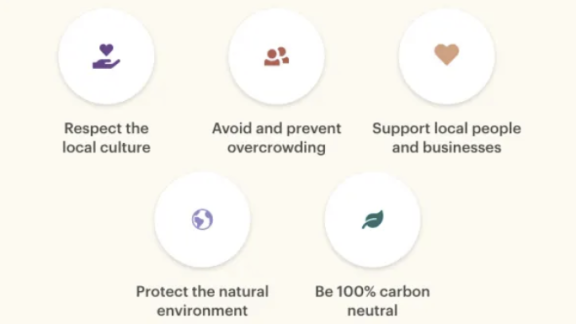
Source: Withlocals, 2024
Since it was founded in 2013, Withlocals has generated over €25 million in income for local hosts and local businesses; in 2022 the platform generated over €8.1 million. All hosts are encouraged to support local businesses and around 50% of hosts’ earnings were spent with local businesses. Withlocals offsets all carbon emissions with partner Chooose, offsetting 1,800 tonnes of carbon emissions in 2022. In the same year, Withlocals achieved B Corp certification, representing a high level of social and environmental responsibility.
The broad sustainable actions the operator undertakes include:
- Respecting and protecting people, animals, planet, different cultures and different ideas.
- Maximising local benefits to empower locals, improve livelihoods and boost local economies.
- Working to reduce the impact of tourism on climate change.
To find out how Withlocals measures its sustainability actions, read their Impact Report 2023.
Tips:
- Assess your own business for sustainability. See where you can put more sustainable actions in place. If you have a website, make sure to mention what sustainable actions you do, even if you are not yet certified. Buyers will want to know how you are taking steps to reduce your impact on people, places and the planet.
- Use CBI studies on the tourism sector to help you put sustainable actions in place: those on going green and being socially responsible have lots of helpful advice.
2. Through which channels can you get urban experiences on the European market?
The market for urban experiences is very broad. Tourists on all types of holidays – independent, package, visiting family, and friends and business – may choose to book an urban experience while on a trip. They are most likely to book through an OTA or directly from a tour operator's website.
How is the end market segmented?
Many types of tourists will choose to take part in an urban experience:
- Fully independent travellers (FIT): FITs make all their own travel arrangements. They are big users of urban experiences and will book either before they arrive or while at the destination.
- Tourists on package, group or tailor-made tours: budget, mid-range and luxury. During downtime they might choose to book a food tour or cultural experience, depending on what’s included in their package.
- Visiting family and friends (VFR) and Diaspora markets: this group consists of tourists with family or heritage connections to a destination. These are often domestic and regional markets.
- Business travellers: particularly those who also take some leisure time while on a business trip.
All major generations of baby boomers, Gen X, Gen Y and Gen Z like to participate in urban experiences when they visit city and town destinations. Each consumer group has different motivations and travel characteristics. This makes the market for urban experiences competitive, but also offers good opportunities for local operators to find gaps in the market for unique and different tours.
Tip:
- Read the market potential report The European market potential for urban experiences tourism to find out more about the end market segments for urban tourism.
Through which channels does a product reach the end market?
The main sales channels for urban experiences are OTAs and direct sales, as shown in the chart below.
Figure 2: Sales process for urban experiences
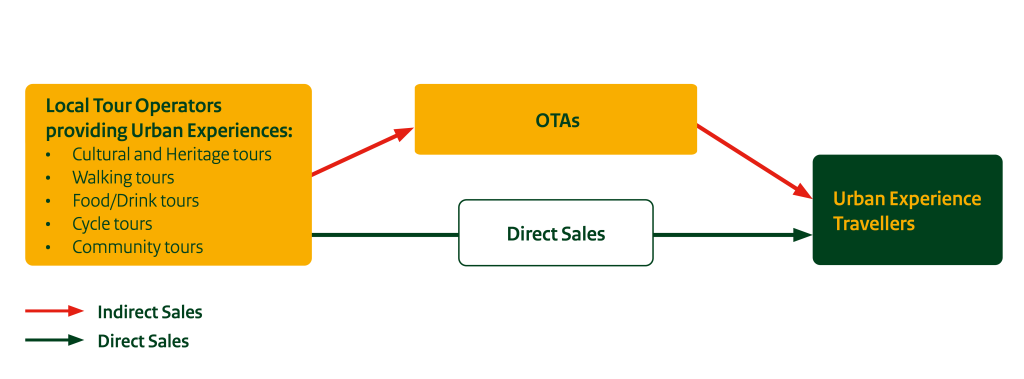
Source: Acorn Tourism Consulting, 2024
OTAs: OTA platforms for selling trips, tours and experiences is a fast-growing sales channel. They allow consumers to browse and compare many options on one single platform. They have large marketing budgets and can help small operators reach markets they would never get with their own website. They charge a commission on every sale made, usually between 15% and 30%. Below are some OTAs that specialise in tours, activities and experiences, including urban experiences:
- City Unscripted is a British a platform specifically for urban experiences.
- GetYourGuide is a large OTA based in Germany that is predominantly used by European travellers. Other European platforms are Musement (Italy), Civitatis (Spain) and Ceetiz (France).
- Asian platforms like Klook and Veltra.
- Several OTAs are for local guides to market their tours. Withlocals is a Dutch platform for independent local guides in city destinations. Showaround is a similar platform aimed at European travellers. Tours by Locals is aimed at the US market.
- Eatwith and Traveling Spoon specialise in food and drink experiences in worldwide destinations. Viator is the world’s largest OTA, owned by Tripadvisor. Its market is predominantly North America. It features many hundreds of thousands of experiences across many niches.
A note about Airbnb Experiences: Airbnb paused the Airbnb Experiences platform for new suppliers in April 2023. There is no current information as to when the platform will be back up for new experiences.
Direct Sales: The direct sales route refers to sales made through your website and/or your business Facebook page (if you do not have a website). You can also use Instagram and TikTok to direct potential customers to your website.
To maximise direct sales, you should set up a Google My Business profile. This way your business can be found on Google Maps and Google Things to Do. Google Things to Do is often used by travellers once they’re in a destination and searching for things to do locally. This is particularly useful for operators of urban experiences.
What is the most interesting channel for you?
Both sales channels are interesting for urban experiences and you should explore using them together for maximum effect. To work with OTAs you will need to do lots of research to identify the right one for your business. Most OTAs make the benefits of working with them very clear, like GetYourGuide.
Figure 3: Why sell on GetYourGuide
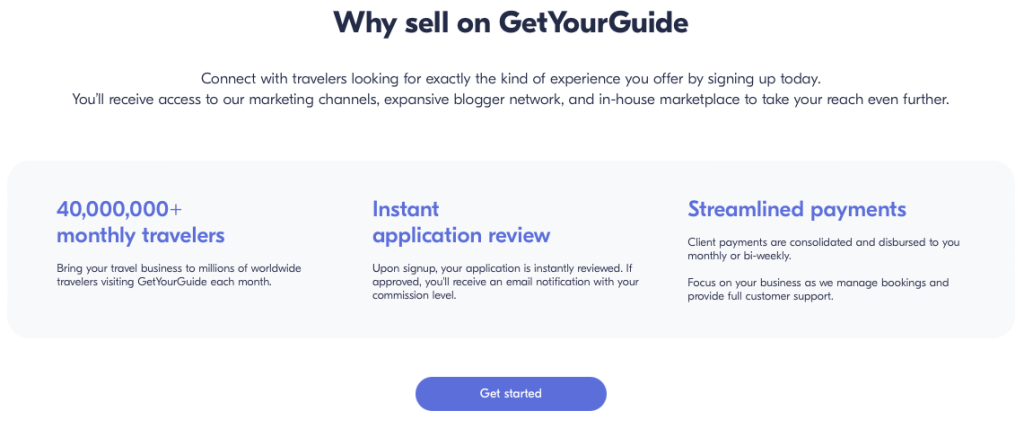
Source: GetYourGuide, 2024
To find out more about OTAs, consult the CBI study How to work effectively with OTAs. To create or improve your website, read the CBI study How to be a successful tourism company online?
Tip:
- Explore OTAs on the market to see which would best suit your needs. You can also use OTAs to find out what other urban experiences are already in your destination and see where you could add something different to your tour.
3. What competition do you face on the European urban experiences market?
Urban experiences can be operated in any town or city where a story can be told and there is demand. It is therefore a very competitive market. But because there are so many possibilities, great marketing and product development skills are critical in order to stand out. The countries below give best practices of some of the most attractive markets for urban experiences.
Which countries are you competing with?
Many countries around the world have an established market for urban experiences. Some of the leading cities for urban tourism in long-haul destinations from Europe are Bangkok, Tokyo, Seoul, Kuala Lumpur, Mexico City, Rio de Janeiro, Buenos Aires, Ho Chi Minh City and Cairo. Lesser-visited cities and towns in the same countries are also good destinations for urban experiences. The four countries of Morocco, Colombia, Vietnam and India are profiled below as examples of destinations where urban and city tourism is particularly strong.
Morocco
Morocco’s fascinating culture and vibrant cities are great for urban experiences. Located in the foothills of the Atlas Mountains, Marrakesh is a cultural hotspot of bustling souqs (markets), maze-like alleys and numerous street food stalls. Many tours take in the famous medina (main square), Jemaa el-Fna, which is a hive of activity from dawn to dusk. The beautiful city of Chefchaouen in the Rif Mountains is one of Morocco’s ‘hidden gems’ and off the beaten track, known for its blue-washed buildings cascading down the mountainside.
Other popular city and town destinations are Fez, full of cultural treasures like mosques, palaces and fountains, and the Atlantic port city of Essaouira. On the edge of the Sahara, Ouarzazate is the gateway to the desert and has been the location of many famous movies, including Lawrence of Arabia, The Mummy and Gladiator. Tours focusing on pop culture are very popular these days – visiting places made famous in films, TV series and music.
Experience-orientated spending is rising strongly in Morocco, up by 117.5% in March 2023, compared to the previous year.
Colombia
Colombia’s rich and varied culture makes it a top terminus for urban experiences and one of the continent’s leading destinations for culture. Bogotá’s history is evident from its vast numbers of colourful, elaborate murals (graffiti), which make for great walking tours. Bogotá is also a foodie city, from street food to high-end restaurants. Medellín was once amongst the most dangerous cities in the world on account of its infamous drug cartel. However, the city is now one of peace and Comuna 13 is now a colourful tourist attraction, full of murals that are tributes to the families and what they endured over the years.
On the northern coast, the colonial city of Cartagena is one of the most picturesque in South America. The walled city is a maze of streets, full of local life and culture, which are so essential for an urban experience. In southern Colombia, Cali is a smaller city known for its love of music and festivals.
Vietnam
Vietnam has a huge variance between north and south, making it a very vibrant country. In the north, Hanoi’s culture is centred around its heritage and food; it is well-known for its street food culture, with vendors all over the city. Food tours are very common in Hanoi. The lesser-visited city of Cao Bang is surrounded by small towns and villages where tours of traditional community life take in activities like incense-making.
Hoi An in Central Vietnam is a UNESCO World Heritage Site that has a distinctly ancient feel, full of iconic architecture, temples, tea houses and traditional merchants. Hue, home to Vietnam’s royal history, is a hotspot for historical tours to explore the country’s Buddhist roots. Ho Chi Minh City is Vietnam’s largest city, located on the Mekong Delta. The city is well-known for floating markets and life on the river, and many river tours are conducted to explore the waterways.
The Vietnamese tourist board has dedicated a section of its website to city tourism, encouraging visitors to ‘get a taste of urban Vietnamese culture’. This emphasises the importance of the niche to the country’s tourism sector.
India
India is a leading destination for urban experiences, with hundreds of cities all over the vast country that are full of vibrant culture and heritage. The big cities are clear tourist hotspots for a huge range of urban experiences, such as Mumbai, Delhi, Agra and Kolkata. But there are many more lesser-visited cities that offer strong urban experiences.
Jodhpur is Rajasthan’s ‘cobalt city’, painted blue by the city’s Brahmins to deter insects and keep the city cool in the summer. Chennai, the capital of Tamil Nadu in the south, is known for its cricket heritage as well as its vegetarian food. In the northern hill stations, popular Leh is the picturesque capital of Ladakh, while lesser-visited Tawang provides a great opportunity to soak up Tibetan spirituality and Buddhist culture. Varanasi, located on the bank of the River Ganges, is India’s spiritual centre.
City tourism is an important niche in the country, and India’s tourist board, Incredible India, highlights 74 of India’s city destinations amongst its key cultural attractions.
Figure 4: Motorbike tours are popular urban experiences in Rishikesh, India
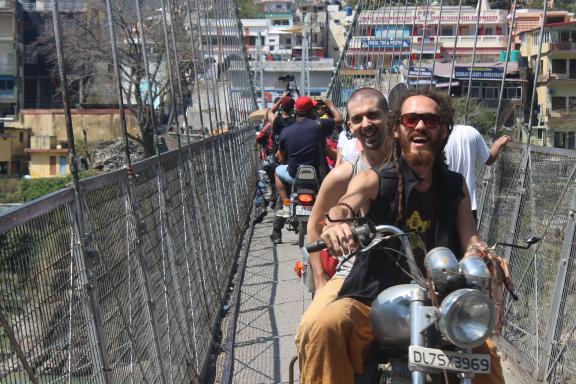
Source: Jeevan at Pixabay, 2015
Key Takeaways:
- Research urban experiences in your destination, neighbouring regions and other countries. Be inspired by what other local operators and tour guides offer. Detect the gaps in the market so you can do something different.
- Get in touch with your tourist board to see what information and support they can offer. For instance, check if you can place your link on their website, and the other way round.
Which companies are you competing with?
Companies providing urban experiences are a mix of small tour operators and local tour guides who work independently. Independent tour guides usually list themselves/their tours on OTAs like Withlocals and GetYourGuide. Some have their own website too, and/or a Facebook page. Both types of providers are very common all over the world.
Morocco
Marrakech Tour Guide offers a small range of private and small group tours in and around Marrakech. It has a very detailed website with lots of information for potential customers, including several blogs. The operator is well connected on social media, with a Facebook business page, Marrakech Tour Guide Official, and a link to its Tripadvisor page. It also has a Google Business Profile so it can be found on local searches. This means the operator is doing all it can to maximise its chances of being seen by travellers.
Fab Fez Tours offers a small range of artisan, cooking, photography and walking tours. The business is managed by Fatima, an independent, government-licensed female tour guide. She leads a Female Life Tour, exploring how Moroccan women live. This is a good example of a tour that offers something a little different than usual sightseeing tours.
Her website is contemporary and intuitive, making it a pleasant experience for travellers, who will be keen to find out more. It is linked to her Instagram account.
Colombia
Zippy Tour is a small local tour operator that offers tours of Comuna 13 and Guatapé in Medellín. Comuna 13 was once the most dangerous area of the city. Now it is a testament to the success of the city’s transformation to peace. Particularly appealing to Gen Z, the tour of Comuna 13 includes storytelling, artistic elements such as graffiti, dance and art, and passionate local guides. The tour is free and tips are encouraged.
The True Colombian Experience offers a range of cultural and historical tours, gastronomical tours and sporting events in Bogotá. The business is made up of a team of professional guides, and experiences are designed to ensure authentic contact with local people. The website features profiles of all the guides, which is a good idea to bring them to life for visitors. The operator includes organisations it is associated with, including the tourist board.
Vietnam
Hanoikids is a voluntary tour-guiding club established in 2005, managed by students. It offers tours for English-speaking visitors led by students who also want to improve their English. It aims to bring insight into Vietnamese culture and tradition, and develop cross-cultural understanding between Vietnam and visitors. The club offers two types of urban tours – a city tour and a food tour, both a combination of walking and taxi tours. The website is simple and includes a good blog page with lots of useful information for visitors. It also promotes its tours on Tripadvisor.
Heaven and Earth Bicycle Tours has been offering cycle tours around Hoi An in Central Vietnam since 2009. They have half- or full-day cycle tours in easy terrain, visiting small villages and towns in the region. Tours can combine cycling and cooking, or are private cycle tours. Morning cycle tours include a meal with a family in a traditional Vietnamese home. The operator aims to help visitors discover a different side of Vietnam, off the beaten track.
Their website mentions businesses that have recommended the tour operator, like travel guides Lonely Planet and Le Routard. It also has a section on sustainability, which is increasingly important to attract European customers today.
India
Jodhpur Blue City Trip is a local tour operator that offers urban experiences, including the Blue City walking tour, a local cooking class, and the Bicycle Tour of the Blue City. The website is attractively designed, with lots of images showing customers enjoying themselves on trips. The operator has a Google Business Profile so it appears on Google Maps and on local searches. The website is not optimised for online sales and relies on customers to get in touch via email or WhatsApp. Although customer testimonials link from Google, it would be a good idea for this operator to link with any social media platforms it has.
Roobaroo Walks invites travellers to ‘explore India with incredible storytellers and artists’. It offers walking tours in several Indian cities, including Jaipur, Lucknow, Amritsar and Bangalore. The business is made up of specialist guides in their fields, such as historians, musicians, photographers and yogis who want to share their love of India with tourists. Each ‘storyteller’ has their own profile. As well as walking tours, the operator runs multi-day tours to festivals and other cultural events, along with workshops.
The website is simply but intuitively designed. Its blog section is inventively called ‘Stories’, which makes a nice link to its USP (unique selling point) of storytelling. See in the infographic below how they use travel, culture and community to engage with the user to encourage a connection. Simple infographics like this can get strong messages across.
Figure 5: Exploring urban India with storytellers and artists
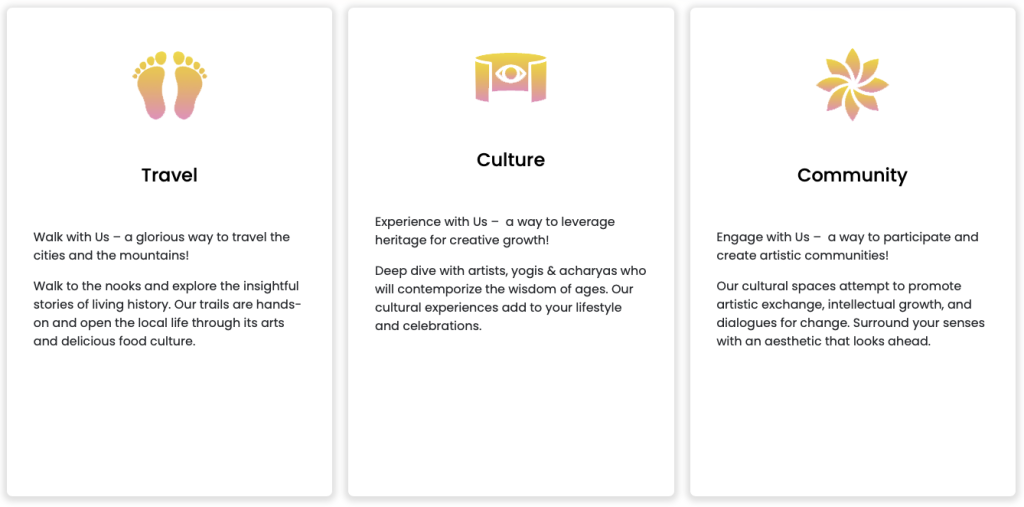
Source: Roobaroo Walks, 2024
Key Takeaways:
- Maximise your online presence. If you sell your tours through an OTA, it is recommended that you also have a website and/or social media platforms so potential customers can find you more easily.
- Set up a Google Business Profile so you can be found on local searches. Having a Google Business Profile means you will also show up on Google maps.
- Consider offering a free tour. You can expect to receive tips, which may bring in more income from generous tourists if they’ve really enjoyed it. Offering a free tour is great for repeat business and establishing your business.
- Think how you can create a tour that is different from all the others on the market. Consider broadening your customer base by offering tours for women only and for LGBTQ+ customers, and accessible tours if you can cater to travellers with disabilities.
Which products are you competing with?
The main competition for urban experiences is special half-day or full-day trips in or out of city/town destinations. These are likely to be more adventure-based, such as hiking, cycling or road trips in the countryside, or kayaking or rafting. Ecotourism and nature adventures may also be part of the competition. OTAs have many thousands of day trips to choose from, both urban and rural, or even a mix of the two. You will have to work hard to make yours stand out from the crowd.
4. What are the prices of urban experiences on the European market?
Prices for urban experiences vary widely. Walking tours are usually the cheapest, as operators have very little overhead. If entry to an attraction or food/drink is part of the tour and is not included in the price you quote, make sure the visitor knows this in advance. It is useful to give them an idea of how much extra they should budget for when they join your tour.
The table below illustrates some types of urban experiences on the market and prices.
Table 1: Sample prices for urban experiences in competing destinations on the European market, April 2024
| Tour | Country | Duration | Price per person € |
| Comuna 13 tour with street food, Medellín | Colombia | 3 hours | 12.72 |
| Salsa and resistance street art tour, Cali | Colombia | 3 hours | 12.72 |
| Morning boat ride with temples, Varanasi | India | 2.5 hours | 26.65 |
| Calligraphy workshop - write your way to happiness | India | 4 hours | 27.76 |
| Uncover hidden gems on a half-day walking tour, Marrakech | Morocco | 4 hours | 28.48 |
| Hanoi food tour with train street visit | Vietnam | 3.5-4 hours | 29.61 |
| Morning cycle tour in Hoi An with lunch at a local family’s house | Vietnam | 6.5 hours | 31.48 |
| Explore the hidden gems in the blue city of Chefchaouen | Morocco | 3 hours | 32.28 |
| 9-dishes cooking class experience | India | 3 hours | 33.30 |
| The Bogotá Food Experience | Colombia | 3-4 hours | 36.89 |
| Jaipur Food Walk | India | 3 hours | 38.86 |
| Flavours of Fez: market visit and a hands-on cooking class | Morocco | 4 hours | 47.47 |
| Mehrangarh Fort and Blue City private guided tour, Jodhpur | India | 4 hours | 47.73 |
| Moroccan sculpture art experience, Fez | Morocco | 2.5 hours | 50.88 |
| The True Colombian Football Experience | Colombia | 3 hours | 63.72 |
| Hidden gems Vespa tour in Hoi An | Vietnam | 4.5 hours | 73.10 |
| Cai Rang floating market and My Tho boat tour, Ho Chi Minh City | Vietnam | 12 hours | 117.52 |
Source: Acorn Tourism Consulting, 2024
Tips:
- Make sure you know how to set your prices right for maximum profit. The blog 7 tips to find the right price for your tours is a helpful tool.
- Do not forget to factor in the commission you will be charged by the OTA. It can be as high as 30%. Read the CBI study How to work effectively with OTAs, it is another helpful tool.
Acorn Tourism Consulting Limited carried out this study on behalf of CBI.
Please review our market information disclaimer.
Search
Enter search terms to find market research
